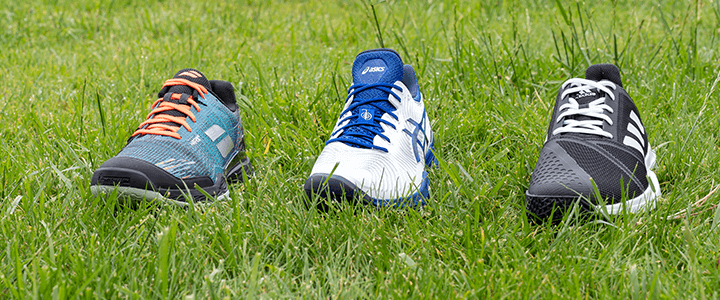Check out my custom vibration dampener
Types of Tennis Shoes
A Buyer’s Guide for Selecting a New Pair
We hope you love this article. Just so you know, TennisCompanion may collect a small share of sales from the links on this page to help keep this site running. Learn more.
There’s a wide range of tennis shoes available to cater to the needs and preferences of different players and court surfaces.
Instead of relying purely on style or what your favorite player is using, it can be helpful to learn about the various types of tennis shoes available so you can make an informed buying decision.
Doing so will help ensure you protect your health, perform your best, while also saving you money in the process.
Article Contents
Click below to jump to a section
Tap below to jump to a section
Different Court Types
Categories of Tennis Shoes
Premium vs. Inexpensive
Level & Style of Play
Models from Top Brands
Where to Buy
New to TennisCompanion?
Create a free account and explore my latest videos below
Tennis Shoes for Different Types of Courts
In tennis, the three primary court surfaces are:
- Hard
- Clay
- Grass
When buying a new pair of tennis shoes, the type of court surface you’re playing on most frequently will dictate the ideal shoe.
Each court surface exhibits different playing characteristics and presents unique challenges for players to achieve proper traction, which is necessary to compete safely and perform their best.
Luckily, tennis shoes have evolved, and we now have a greater variety available to choose from, which includes models that have outsoles designed to cater to the demands of each court surface.
Hard Court

Although the popularity of court surfaces varies in different countries around the world, hard courts are the most common because they’re easy to maintain, which also makes them affordable over the long haul.
If you spend most of your time on hard courts, then it’s important to make sure that your shoes offer design features to stand up to the harsh demands of this court surface.
Here are a few characteristics to look out for when playing on hard courts:
- Durable outsole with a prominent toe guard and reliable tread
- Added comfort and shock absorption
- Extra protection around the shoe’s upper
- Stability for quick starts and stops
Since most players play on hard courts, the vast majority of available tennis shoes feature outsoles that are ideal for hard courts. Typically, when a pair doesn’t have an explicit clay or grass court label, it’s safe to assume that it’s acceptable for hard court use.
Clay Court

The second most common court surface in tennis is clay, which also happens to play the slowest because the ball loses speed and bounces higher after hitting the ground.
Clay courts are slick, and players frequently slide on the court. Also, because clay is a loose surface, it regularly gets stuck within the tread of a tennis shoe’s outsole, which can cause a player to lose traction.
For the best performance on clay, here are few things to keep in mind:
- A herringbone style tread throughout the entire length of the shoe, which naturally releases clay when the shoe flexes or twists while also helping ensure consistent slides
- A tightly knit or woven upper to prevent dust and clay from entering the top of the shoe during play
- Stability for confident slides especially during lateral or side to side movements
Many of the top tennis shoes are also available in clay court models, but they’re less common than their hardcourt counterparts.
Tennis shoes intended for clay courts are not ideal for hard courts because they don’t offer the durability for them to last. If you buy a pair, you should reserve them for clay courts, but they’ll also work for grass courts.
Grass Court

Despite its prominence in men’s and women’s professional tennis, grass courts are the least common surface because it’s the most challenging and expensive to maintain.
Grass courts are slick, which also makes them the fastest of the three court surfaces – the ball frequently skids and bounces low. As you’d expect, grass courts are more forgiving, so durability is less of a priority. However, traction remains a top priority.
Here are a few design features standard in grass-court shoes:
- A flat outsole with pimples or subtle bumps throughout the entire length of the outsole for optimal traction
- Stability to help ensure confident footing on the slick surface
Most professional tennis players make use of specialized grass court tennis shoes with their distinct bumps on the outsole. However, you won’t find them readily available for purchase because the vast majority of players don’t play on the surface regularly.
That’s where all court tennis shoe’s come in handy.
All Court
These days most tennis players will frequent hard courts with occasional opportunities to hit on clay or grass.
Luckily, manufacturers of tennis shoe’s realize this, so they design most of their shoes first and foremost for hard courts while also being acceptable for occasional clay or grass courts.
For example, a common design feature of all court tennis shoes is a herringbone style tread, which, although won’t perform as well as an authentic herringbone tread on clay, is sufficient.
If your shoes don’t explicitly mention the fact that they’re “all-court,” then, for the most part, it’s safe to assume a pair of hard court shoes will work fine on other court surfaces too.
If you have the opportunity to play on grass courts, it’s worth checking ahead of time that your shoes will be acceptable. Some high-end clubs, such as Wimbledon, have more stringent requirements for shoes to protect the courts.
Popular Categories of Tennis Shoes
With few exceptions, we can bucket most tennis shoes into a handful of categories that players often seek out when buying a new pair.
It’s worth noting that all tennis shoes will tend to offer designs that cater to the basic demands of our sport. However, specific shoes emphasize certain features that players often desire.
Lightweight

As the speed and physicality of tennis have evolved, so has the demands of players seeking every advantage they can get to move around the court faster than the next player.
The result is a relatively newer trend in the popularity of lightweight tennis shoes, which has pushed the boundaries of shoe technology.
Unfortunately, because the weight of shoes varies at different sizes, there isn’t a hard and fast rule that is commonly applied for a shoe to be considered lightweight. However, when comparing the same size across a range of shoes, it becomes clear which models skew in this direction.
Here are a few popular lightweight tennis shoes:
Stability

Regardless of the court surface, stability is fundamental to tennis shoe design. However, some shoes offer more in this category than others.
A few key parts of a tennis shoe that contribute to its stability include:
- Midfoot shank: prevents the shoe from twisting
- Heel counter: provides rigidity at the heel
- Heel collar: helps keeps the foot securely in place
- Lacing system: ensures a snug fit and reduces slipping
- Upper: material(s) that wrap the top of your foot
Despite advancements in materials and design, lightweight tennis shoes typically don’t offer the same level of stability as their heavier counterparts. Of course, the extra weight alone doesn’t increase stability. Instead, it’s the strategic use of added material that helps enhance it.
A few popular tennis shoes with terrific stability include:
Durability

One of the most common complaints about tennis shoes is their durability, which is more prevalent for hard court players.
The outsole, which is always in direct contact with the abrasive surface of the court, is where players experience the most significant issues.
However, the toe of a shoe and the upper periodically come in contact with the court, so added protection in these areas can be beneficial.
Here are a few tennis shoes with excellent durability:
If you suffered from durability issues with a pair of shoes, it’s worth taking note of where it was a problem so that you can make sure your next pair has optimized protection in those areas.
Premium vs. Inexpensive
On your hunt for a pair of tennis shoes, you’ll likely come across a handful of tennis shoes nearing the $200 price tag, while many others fall at or well below the hundred dollar mark.
On the higher end of the spectrum, you’re dealing with the best premium tennis shoes that offer exceptional performance to keep up with the demands of advanced tennis players while also making use of the latest technologies.
As a beginner, there’s nothing wrong with springing for an expensive model. However, in many cases, what they offer will likely be overkill because you’re either not playing enough tennis or your skills and movement aren’t far enough along to warrant the added expense.
More affordable or cheap tennis shoes, in comparison to the premium models, tend to offer fewer features and older technologies, which are perfectly acceptable and fantastic options for recreational or club players.
Level & Style of Play
As you shop around for a new pair of tennis shoes, it’s worth keeping in mind your level and style of play to help find the ideal match.
If you’re new to the game and learning how to play, then an inexpensive pair of all court tennis shoes is likely a great option to start. However, if you’re an intermediate to an advanced tennis player, you’ll want to ensure your shoes meet the higher-level demands of your game.
Similarly, your style of play can help dictate the type of shoe that might make the most sense for you. An aggressive baseliner that’s continually running side to side might opt for an ultra-stable pair, while an all-court player might select a lightweight pair for maximum speed.
Shoe Models from Top Tennis Brands
Most of the game’s best tennis shoe brands offer different types of footwear to cater to a wide range of player preferences. Let’s take a look a some of the most popular and the tennis shoes they have on offer.
Nike
- Air Zoom Vapor
- Air Zoom Cage
- Air Zoom Zero
- Air Zoom Prestige
- Air Max Wildcard
- Air Max Vapor Wing
- Flare
- Court Lite
Adidas
- Stycon
- SoleCourt Boost
- SoleMatch Bounce
- Stella Barricade Boost
- Defiant Bounce
- Adizero Ubersonic
- Adizero Club
- CourtJam
- GameCourt
Asics
- Court FF
- Court Speed
- Gel Resolution
- Gel Challenger
- Gel Game
- Gel Dedicate
- Solution Speed FF
K-Swiss
- Aero Knit
- Ultrashot
- Hypercourt Supreme
- Hypercourt Express
- Aero Court
- Bigshot lite
New Balance
- Fresh Foam Lav
- 1296
- 1006
- FuelCell 996
- 896
- WC806
- 796
- 696
Fila
- Axilus Energized
Lotto
- Mirage 100
- Mirage 200
- Mirage 300
- Stratosphere
- Space
Babolat
- Propulse Rage
- Propulse Fury
- Propulse Blast
- Jet Mach II
- Jet Tere
- SFX
Head
- Sprint
- Revolt
- Brazer
- Diadora
- Speed Blueshield
- Speed Star K
- Speed Competition
- Yonex
- Eclipsionmen
- Fusion Rev
- Sonicage
Wilson
- Amplifeel
- Rush Pro
- Kaos
Mizuno
- Wave Exceed Tour
- Wave Exceed SL
- Wave Impulse
Prince
- T-22
- T-22 Lite
Where to Buy New Tennis Shoes
Once you’ve figured out which type of tennis shoe meets your need, there are a variety of locations you can pick up your next pair.
Here are a few worth checking out.
Local Tennis Shop
One of the first places worth checking out a new pair of tennis shoes is your local tennis or pro shop. We love supporting smaller retailers, and you’re likely to get extra attention from helpful tennis players that have first-hand experience with the gear they offer.
Pros
- Expertise
- Try on multiple styles
- Support local businesses
Cons
- Small selection
Big Box Sports Retailers
Larger sporting goods stores are often an excellent option for finding your next pair of tennis shoes. They’ll typically offer a decent selection, but because they cater to a wide range of sports, it won’t be the largest, and you’ll be hard-pressed to find anyone who can speak to the shoes.
Pros
- Decent selection
- Competitive prices
Cons
- Lack of expertise
Speciality Online Retailers
For the broadest selection of tennis shoes, check out online retailers that specialize in tennis. They’re in the business of serving tennis players, so they’ll always have the latest models on hand, and they usually invest heavily in providing their users with in-depth buyer’s resources.
Pros
- Wide selection
- In-depth buyers resources
Cons
- Have to wait or pay for delivery
- Return and wait if shoes don’t work for you
Major Ecommerce Websites
Some of the largest eCommerce websites are great options for buying your next pair of tennis shoes. However, the companies don’t specialize in tennis, so don’t expect any particularly helpful resources.
Pros
- Wide selection
- Fast and often free delivery
Cons
- Lack of expertise and buyer resources
- Return and wait if shoes don’t work for you
Wrapping Up
Every tennis player has a unique set of needs, and learning about the different types of tennis shoes is an excellent way to help ensure you purchase the right pair that enables you to perform your best.
Hopefully, you found this guide informative in buying your next pair. If you have any questions, please let us know in the comments below.
Play Better Tennis
Improve your game alongside our community of tennis players
Why join?
Discussion Boards
Join the conversation with other members of the community.
5 Point Friday
Read our weekly recap of the 5 most interesting things we dig up in tennis.



Leave a Reply
Want to join the discussion?Feel free to contribute!